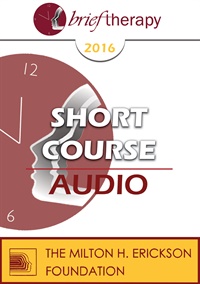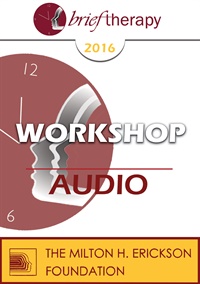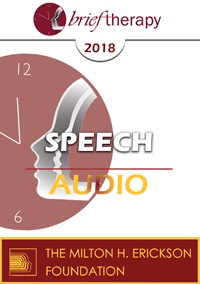
- Average Rating:
- Not yet rated
- Topic Areas:
- Anxiety | Depression | Trauma | Short Courses | Ericksonian Hypnosis and Therapy Techniques | Reality Therapy | Brief Therapy
- Categories:
- Brief Therapy Conference | Brief Therapy Conference 2014
- Faculty:
- Robert Wubbolding, EdD
- Duration:
- 1:29:28
- Format:
- Audio Only
- Original Program Date:
- Dec 11, 2014
- Short Description:
- A demonstration and a 12-minute DVD illustrate how to assist clients to make effective choices satisfying their needs, especially power or inner control. Merging reality therapy with Ericksonian principles helps clients discover and choose alternatives to the manifestations of past trauma, the pain of powerlessness due to anxiety and depression.
- Price:
- $15.00 - Base Price

- Average Rating:
- Not yet rated
- Topic Areas:
- Anxiety | Depression | Trauma | Cognitive Behavior Therapy (CBT) | Hypnosis | Workshops | Ericksonian Hypnosis and Therapy Techniques | Milton Erickson | Brief Therapy | Naturalistic
- Categories:
- Brief Therapy Conference | Brief Therapy Conference 2014
- Faculty:
- Ernest Rossi, PhD | Kathryn Rossi, PhD | Roxanna Erickson Klein, RN, PhD, LPC, LCDC
- Duration:
- 1:59:16
- Format:
- Audio Only
- Original Program Date:
- Dec 12, 2014
- Short Description:
- Ernest Rossi, PhD, Roxanna Erickson-Klein and Kathryn Rossi review the case work of Milton H. Erickson, MD in counseling, psychotherapy, therapeutic hypnosis and rehabilitation as evidence-based cognitive behavior therapy to treat anxiety, depression and trauma. This experiential workshop explores the timeless nature of the work of Milton H. Erickson, who substantially influenced the manner that psychotherapy is practiced in the 21 century.
- Price:
- $15.00 - Base Price
- Average Rating:
- Not yet rated
- Topic Areas:
- Clinical Demonstrations | Hypnosis | Ericksonian Hypnosis and Therapy Techniques
- Categories:
- Brief Therapy Conference | Brief Therapy Conference 2016
- Faculty:
- Michael Yapko, PhD
- Course Levels:
- Master Degree or Higher in Health-Related Field
- Duration:
- 59:00
- Format:
- Audio and Video
- Original Program Date:
- Dec 10, 2016
- Short Description:
- In this demonstration, hypnosis becomes a framework for making difficult life decisions. A volunteer weighing questions of aging, family, and independence experiences how shifting from fear-based thinking to strength-based clarity can open new options. Through metaphors, imagery, and experiential learning, the session shows how hypnosis helps clients find grounded confidence in their choices and greater comfort with uncertainty.
- Price:
-
Sale is $29.00
price reduced from Base Price - $59.00

- Average Rating:
- Not yet rated
- Topic Areas:
- Conversation Hours | Ericksonian Hypnosis and Therapy Techniques | Hypnosis
- Categories:
- Brief Therapy Conference | Brief Therapy Conference 2016
- Faculty:
- Michael Yapko, PhD
- Duration:
- 56:29
- Format:
- Audio Only
- Original Program Date:
- Dec 10, 2016
- Short Description:
- In this open conversation, clinical questions from the field bring depression treatment into sharp relief. From handling crisis calls in minutes to supporting families impacted by a loved one’s despair, the discussion shows how expectancy, coping style, and experiential methods shape outcomes. Participants hear practical examples of hypnosis, behavioral activation, and skill-building strategies that help clients move from hopelessness to resilience—even in the toughest circumstances.
- Price:
- $15.00 - Base Price

- Average Rating:
- Not yet rated
- Topic Areas:
- Short Courses | Utilization | Interviewing | Ericksonian Hypnosis and Therapy Techniques | Psychotherapy | Hypnosis
- Categories:
- Brief Therapy Conference | Brief Therapy Conference 2016
- Faculty:
- Brent Geary, PhD | Claudia Weinspach, Dipl. Psych
- Duration:
- 1:21:38
- Format:
- Audio Only
- Original Program Date:
- Dec 08, 2016
- Short Description:
- Milton Erickson’s counsel to “Take what the patient brings” encapsulated the utilization approach that he introduced in hypnosis and psychotherapy. This workshop is designed to enhance participants’ awareness of and ability to use the many facets of utilization that are elicited during clinical interviews. Two demonstrations will be included.
- Price:
- $15.00 - Base Price

- Average Rating:
- Not yet rated
- Topic Areas:
- Short Courses | Anxiety | Ericksonian Hypnosis and Therapy Techniques | Meditation, Spirituality and Yoga | Psychotherapy | Therapist Development
- Categories:
- Brief Therapy Conference | Brief Therapy Conference 2016
- Faculty:
- Wei-Kai Hung, M.Ed., L.M.H.C., L.P.C.
- Duration:
- 1:25:33
- Format:
- Audio Only
- Original Program Date:
- Dec 08, 2016
- Short Description:
- This workshop will blend Zen and Ericksonian wisdom into a modern psychotherapy which provides an efficient solution for clients’ anxiety. Instead of doing therapy, therapists are invited to experience Zen wisdom, and find a creative and efficient way to help clients finding their own wellbeing. These pathways to presence and creativity will lead you to the realization of the “Therapist’s Zen state” which not only provides a creative opening, but also makes therapeutic sessions easy and fun.
- Price:
- $15.00 - Base Price

- Average Rating:
- Not yet rated
- Topic Areas:
- Short Courses | Anxiety | Ericksonian Hypnosis and Therapy Techniques | Meditation, Spirituality and Yoga | Solution Oriented Approach | Strategic Therapy
- Categories:
- Brief Therapy Conference | Brief Therapy Conference 2016
- Faculty:
- Joseph Dowling, MS, LPC
- Duration:
- 1:27:39
- Format:
- Audio Only
- Original Program Date:
- Dec 08, 2016
- Short Description:
- Zonefulness is the integration of mindfulness mediation, hypnotic zone exercises, and solution-oriented/strategic therapy. This workshop will enable participants to learn How To Become Smart Enough To Know When To Stop Thinking; How To Dismantle Atomic What-Ifs; and how to seamlessly access their peak performance zone. This workshop will afford participants to experience group hypnotic zone exercises, a live client demonstration, as well as a discussion of case studies. The work and influence of Dr. Milton H. Erickson will be highlighted throughout the entirety of the presentation.
- Price:
- $15.00 - Base Price

- Average Rating:
- Not yet rated
- Topic Areas:
- Short Courses | Unconscious Processes | Resistance | Couples Therapy | Ericksonian Hypnosis and Therapy Techniques | Utilization
- Categories:
- Brief Therapy Conference | Brief Therapy Conference 2016
- Faculty:
- Bruce Gregory, PhD | Birgitta Gregory, PhD
- Duration:
- 1:25:18
- Format:
- Audio Only
- Original Program Date:
- Dec 08, 2016
- Short Description:
- This workshop will address how the principles and variables of quantum physics can be integrated in the transformation of resistance in individuals and couples. The Erickson Resistance Protocol will be utilized as a metaphor and template to support the expansion of trust and creativity within the professional in the transformation of resistance.
- Price:
- $15.00 - Base Price

- Average Rating:
- Not yet rated
- Topic Areas:
- Hypnosis | Short Courses | Utilization | Brief Therapy | Ericksonian Hypnosis and Therapy Techniques | Self-Hypnosis
- Categories:
- Brief Therapy Conference | Brief Therapy Conference 2016
- Faculty:
- Jeffrey Feldman, PhD
- Duration:
- 1:21:10
- Format:
- Audio Only
- Original Program Date:
- Dec 08, 2016
- Short Description:
- This short course will introduce two self-hypnotic techniques. The first builds upon the “heart lock in” technique of Hearthmath. The second transforms psychomotor agitation to a self-soothing rhythmic brain input that enables individuals to “get in touch with the wealth of life experience at their fingertips”.
- Price:
- $15.00 - Base Price

- Average Rating:
- Not yet rated
- Topic Areas:
- Workshops | Ericksonian Hypnosis and Therapy Techniques | Experiential Therapy | Relationships
- Categories:
- Brief Therapy Conference | Brief Therapy Conference 2016
- Faculty:
- Stephen Lankton, MSW
- Duration:
- 1:55:06
- Format:
- Audio Only
- Original Program Date:
- Dec 09, 2016
- Short Description:
- Milton Erickson taught that symptoms were a breakdown of relations between people. Looking at personal or family traumatic problems through this lens it is relatively easy to recognize the existence and connection between past and present disordered relationships. More importantly, the required experiential resources that individuals need to correct these conditions becomes apparent. Once identified, therapy can concentrate on helping trauma-suffering clients acquire needed experiences and help clients learn to use them systematically and appropriately.
- Price:
- $15.00 - Base Price

- Average Rating:
- Not yet rated
- Topic Areas:
- Meditation, Spirituality and Yoga | Workshops | Mind-Body | Ericksonian Hypnosis and Therapy Techniques | Neuroscience
- Categories:
- Brief Therapy Conference | Brief Therapy Conference 2016
- Faculty:
- Ernest Rossi, PhD | Carolyn Sauer, Psy.D.
- Duration:
- 2:32:44
- Format:
- Audio Only
- Original Program Date:
- Dec 09, 2016
- Short Description:
- How can we optimize classical yoga with Ericksonian mind-body work? This experiential workshop utilizes Ericksonian approaches with the entire audience as well as individual volunteers. Through story and movement we will access new dimensions of our emerging consciousness with the 4-stage creative psychosocial genomic cycle. Open for all fitness levels.
- Price:
- $15.00 - Base Price

- Average Rating:
- Not yet rated
- Topic Areas:
- Depression | Workshops | Ericksonian Hypnosis and Therapy Techniques
- Categories:
- Brief Therapy Conference | Brief Therapy Conference 2016
- Faculty:
- Michael Yapko, PhD
- Duration:
- 2:33:04
- Format:
- Audio Only
- Original Program Date:
- Dec 11, 2016
- Short Description:
- This workshop shows how depression is sustained by patterns of global thinking, passivity, and poor decision-making. Through clinical examples—from clients overwhelmed by unrealistic goals to those caught in rigid self-definitions—participants see how psychoeducation, hypnosis, and experiential learning can shift perspectives. The session highlights practical ways to strengthen coping, reduce relapse, and help clients move from helplessness to resilience.
- Price:
- $15.00 - Base Price
- Average Rating:
- Not yet rated
- Topic Areas:
- Workshops | Therapist Development | Ericksonian Hypnosis and Therapy Techniques
- Categories:
- Brief Therapy Conference | Brief Therapy Conference 2016
- Faculty:
- Michael Yapko, PhD
- Course Levels:
- Master Degree or Higher in Health-Related Field
- Duration:
- 2:37:59
- Format:
- Audio and Video
- Original Program Date:
- Dec 11, 2016
- Short Description:
- This session explores the central role of discrimination strategies in therapy, emphasizing how ambiguity, global thinking, and rigid philosophies increase vulnerability to depression and anxiety. Participants learn practical methods for guiding clients to distinguish controllable from uncontrollable factors, useful analysis from rumination, and realistic from unrealistic expectations. Through humor, metaphor, and clinical demonstration, the workshop highlights how critical thinking and reality testing can transform therapy into a process of helping clients make better choices in complex situations.
- Price:
-
Sale is $29.00
price reduced from Base Price - $59.00
Tags: Interviewing

- Average Rating:
- Not yet rated
- Topic Areas:
- Workshops | Brief Therapy | Ericksonian Hypnosis and Therapy Techniques | Research | Therapist Development
- Categories:
- Brief Therapy Conference | Brief Therapy Conference 2016
- Faculty:
- Jeffrey Zeig, PhD
- Duration:
- 2:02:54
- Format:
- Audio Only
- Original Program Date:
- Dec 11, 2016
- Short Description:
- Skills and experience, research and theory ... each plays a central role in the development of effective therapy practice. And then there is something else. When we recall the work of such figures as Milton Erickson, Virginia Satir, and Carl Whitaker, we detect another layer: artistry. Surprisingly, artistry is something that can be taught, or more accurately, expanded. Everyone has the capacity. And it is artistry that brings forth all of that skill, experience, research and theory in effective and generative ways.
- Price:
- $15.00 - Base Price
Credit available - Click Here for more information
- Average Rating:
- Not yet rated
- Topic Areas:
- Clinical Demonstrations | Brief Therapy | Ericksonian Hypnosis and Therapy Techniques | Hypnosis | Naturalistic | Therapeutic Relationship | Couples Therapy
- Bundle(s):
- Learning Track - Using Hypnosis
- Categories:
- Brief Therapy Conference | Brief Therapy Conference 2018 | Online Continuing Education
- Faculty:
- Camillo Loriedo, MD, PhD
- Course Levels:
- Master Degree or Higher in Health-Related Field
- Duration:
- 1:03:30
- Format:
- Audio and Video
- Original Program Date:
- Dec 08, 2018
- Short Description:
- As suggested by Milton Erickson, naturalistic hypnosis seems to be one of the best way of utilizing couple’s resources. Frequently couples fail in reaching a deep mutual exchange and complain of being unable to satisfy their needs for intimacy. Hypnotic experience seems to produce by itself a deep contact that rarely develops in their habitual patterns. Specific couple’s responses to hypnotic induction that can be utilized to produce contact and intimacy will be demonstrated. In some other cases couples are caught by conflicts they are unable to solve. A couples hypnotherapist can extend to both couple members rapport, and succeed in obtaining a special relationship that produces more syntonic and attuned behaviors, in which conflict intensity decreases and a greater ability to listen to each other and negotiate con
- Price:
-
Sale is $29.00
price reduced from Base Price - $59.00
- Average Rating:
- Not yet rated
- Topic Areas:
- Master Classes | Hypnosis | Psychotherapy | Ericksonian Hypnosis and Therapy Techniques | Strategic Therapy | Ericksonian Psychotherapy | Experiential Therapy | Hypnotherapy
- Categories:
- Brief Therapy Conference | Brief Therapy Conference 2018
- Faculty:
- Michael Yapko, PhD | Jeffrey Zeig, PhD
- Course Levels:
- Master Degree or Higher in Health-Related Field
- Duration:
- 2:56:13
- Format:
- Audio and Video
- Original Program Date:
- Dec 10, 2018
- Short Description:
- In this interactive master class, live demonstrations show how hypnosis and experiential methods can help clients transform fear into resilience. One volunteer confronts a lifelong fear of deep water, discovering a powerful inner resource through imagery of her father’s love. Another works through the emotional aftermath of divorce, learning new ways to disarm old patterns of intimidation. The session highlights how metaphor, experiential sculpting, and hypnotic reframing can unlock unexpected pathways to strength and healing.
- Price:
-
Sale is $29.00
price reduced from Base Price - $59.00
- Average Rating:
- Not yet rated
- Topic Areas:
- Master Classes | Hypnosis | Psychotherapy | Ericksonian Hypnosis and Therapy Techniques | Ericksonian Psychotherapy | Experiential Therapy | Hypnotherapy
- Categories:
- Brief Therapy Conference | Brief Therapy Conference 2018
- Faculty:
- Michael Yapko, PhD | Jeffrey Zeig, PhD
- Course Levels:
- Master Degree or Higher in Health-Related Field
- Duration:
- 2:43:33
- Format:
- Audio and Video
- Original Program Date:
- Dec 10, 2018
- Short Description:
- This session explores how hypnosis and strategic therapy can help clients untangle patterns of avoidance, self-doubt, and family tension. By using affective dissociation, metaphors, and experiential learning, the master class demonstrates how to separate mood from action, strengthen integrity with self, and foster resilience. Participants gain insight into how language, stories, and relational dynamics can be woven into therapy to create lasting change.
- Price:
-
Sale is $29.00
price reduced from Base Price - $59.00

- Average Rating:
- Not yet rated
- Topic Areas:
- Special Topics | Hypnosis | Ericksonian Hypnosis and Therapy Techniques | Fundamentals of Hypnosis | Psychotherapy | Truisms | Age Regression | Hypnotic Phenomena | Post-Hypnotic Suggestion | Suggestion | Metaphors
- Categories:
- Brief Therapy Conference | Brief Therapy Conference 2018
- Faculty:
- Brent Geary, PhD
- Duration:
- 5:14:31
- Format:
- Audio Only
- Original Program Date:
- Dec 05, 2018
- Short Description:
- This workshop will provide participants with an introduction to the key concepts and techniques of practice in Ericksonian hypnosis. A brief biography of Erickson’s professional life will provide perspective on the extensive contributions he made to the fields of hypnosis and psychotherapy. Terminology of hypnosis will be explained and various approaches to induction will be described and demonstrated. The process of a typical hypnotic session will be outlined. Considerable attention will be afforded the hypnotic phenomena, the essential mechanisms in hypnotic therapy. Erickson’s landmark concepts of utilization and indirection will be explored with particular focus on the use of therapeutic anecdotes and metaphors.
- Price:
- $15.00 - Base Price
Credit available - Click Here for more information
- Average Rating:
- Not yet rated
- Topic Areas:
- Short Courses | Brief Therapy | Trauma | Ericksonian Hypnosis and Therapy Techniques | Mindfulness | Pain and Healing | Somatic Experiences
- Categories:
- Brief Therapy Conference | Brief Therapy Conference 2018 | Online Continuing Education
- Faculty:
- Ronald Alexander, PhD
- Course Levels:
- Master Degree or Higher in Health-Related Field
- Duration:
- 1:31:13
- Format:
- Audio and Video
- Original Program Date:
- Dec 06, 2018
- Short Description:
- This course focuses on helping clients regain momentum after overwhelming experiences by using brief, body-centered interventions. Participants explore how curiosity, movement, and simple awareness practices can loosen rigid trauma responses and reopen access to choice. With an emphasis on resilience-building, the session offers straightforward tools for shifting clients out of collapse and back into a sense of possibility.
- Price:
-
Sale is $29.00
price reduced from Base Price - $59.00

- Average Rating:
- Not yet rated
- Topic Areas:
- Short Courses | Anxiety | Brief Therapy | Utilization | Ericksonian Hypnosis and Therapy Techniques | Experiential Therapy
- Categories:
- Brief Therapy Conference | Brief Therapy Conference 2018
- Faculty:
- Wei-Kai Hung, M.Ed., L.M.H.C., L.P.C.
- Duration:
- 1:25:01
- Format:
- Audio Only
- Original Program Date:
- Dec 06, 2018
- Short Description:
- Alchemy is about transformation process (Linear). Taoism is about going with flow (Circular). Ericksonian is about utilization and experiential therapy (Infinite Possibilities). This experiential workshop will utilize the best of eastern and western philosophical concepts to treat anxiety effectively and efficiently.
- Price:
- $15.00 - Base Price

- Average Rating:
- Not yet rated
- Topic Areas:
- Speeches | Brief Therapy | Ericksonian Hypnosis and Therapy Techniques | Therapist Development
- Categories:
- Brief Therapy Conference | Brief Therapy Conference 2018
- Faculty:
- Jeffrey Zeig, PhD
- Duration:
- 1:00:38
- Format:
- Audio Only
- Original Program Date:
- Dec 09, 2018
- Short Description:
- One way of modeling Milton Erickson is to consider the states that he commonly inhabited when he was conducting psychotherapy. Erickson "states" will be described and examples will be provided.
- Price:
- $15.00 - Base Price
- Average Rating:
- Not yet rated
- Topic Areas:
- Clinical Demonstrations | Ericksonian Hypnosis and Therapy Techniques | Hypnotherapy
- Categories:
- Brief Therapy Conference | Brief Therapy Conference 1998
- Faculty:
- Michael Yapko, PhD
- Course Levels:
- Master Degree or Higher in Health-Related Field
- Duration:
- 56:32
- Format:
- Audio and Video
- Original Program Date:
- Aug 28, 1998
- Short Description:
- This session explores the role of hypnosis in generating therapeutic possibilities, with or without formal trance induction. Emphasizing the view that clients have more resources than they realize, the presentation shows how experiential methods can strengthen self-trust, reduce dependence on external validation, and create openings for growth. Participants gain insight into how hypnosis can be woven into therapy to deepen outcomes.
- Price:
-
Sale is $29.00
price reduced from Base Price - $59.00

- Average Rating:
- Not yet rated
- Topic Areas:
- Workshops | Couples Therapy | Hypnosis | Sex and Sexuality | Ericksonian Hypnosis and Therapy Techniques
- Categories:
- Couples Conference | Couples Conference 2005
- Faculty:
- Jeffrey Zeig, PhD
- Duration:
- 1:47:54
- Format:
- Audio Only
- Original Program Date:
- Mar 06, 2005
- Short Description:
- Covered in this workshop will be an overview of issues in sex counseling; demographic information; issues in assessment; a phenomenological model; Ericksonian assumptions; and couples exercises for enhancing intimacy.
- Price:
- $15.00 - Base Price

- Average Rating:
- Not yet rated
- Topic Areas:
- Workshops | Couples Therapy | Hypnosis | Sex and Sexuality | Ericksonian Hypnosis and Therapy Techniques
- Categories:
- Couples Conference | Couples Conference 2005
- Faculty:
- Jeffrey Zeig, PhD
- Duration:
- 2:38:21
- Format:
- Audio Only
- Original Program Date:
- Mar 06, 2005
- Short Description:
- Continuing from the morning program, covered in this workshop are principles for using hypnosis; advantages of hypnosis in sex counseling; experiential methods; induction approaches for hypnosis and sex therapy; and Erickson cases.
- Price:
- $15.00 - Base Price

- Average Rating:
- Not yet rated
- Topic Areas:
- Couples Therapy | Workshops | Experiential Therapy | Brief Therapy | Ericksonian Hypnosis and Therapy Techniques
- Categories:
- Couples Conference | Couples Conference 2015
- Faculty:
- Jeffrey Zeig, PhD
- Duration:
- 1:49:31
- Format:
- Audio Only
- Original Program Date:
- Apr 26, 2015
- Short Description:
- Milton Erickson was one of the earliest people to work in Brief Therapy model with couples. This workshop will describe advanced advantages of using experiential methods with couples, including enactment technique and sculpting, lecture, demonstration, and small group practice.
- Price:
- $15.00 - Base Price








